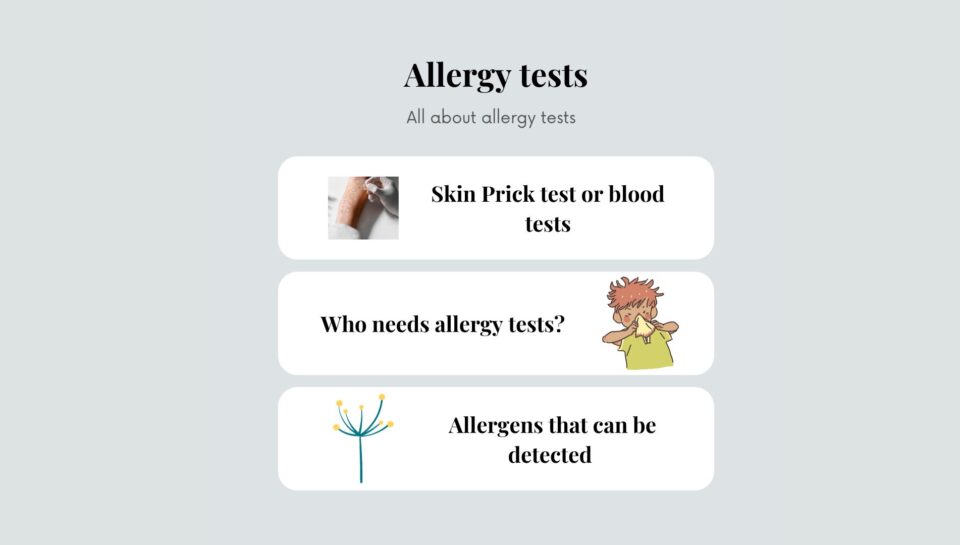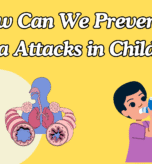Allergy testing can be done in 2 ways.
In vitro testing – A blood sample is taken and tested by using ImmunoCAP ELISA method. Specific allergen IgE levels are detected and compared with reference range. Raised IgE levels indicate sensitization to that particular allergen.
In vivo testing – There are various methods of testing for allergies using the body’s allergic response to the allergen.
Skin Prick Testing (SPT) – Specific allergen extracts are applied on the skin and a small prick is given to instill the allergen drop into the superficial layers of the skin. A positive allergic response is recorded if a swelling appears at the site of the prick. The size of the swelling is measured and compared with a negative (Normal saline) and positive control (histamine). An SPT is considered gold standard for allergy testing as it demonstrates in vivo histamine response to allergens. It is highly specific and give quick results. It is performed by an allergy specialist.
Patch test – This is an intradermal test for occupational allergens like dyes, synthetic materials, chemicals that can cause contact dermatitis. A patch impregnated with different allergens is placed on the back or arm of the patient and allergic reaction is read after 24 hours. It detects IgE mediated reaction to different chemicals. This test is usually performed for skin allergies only and is not useful for respiratory allergies.
Prick-Prick test – If a child has allergic response to some specific food item, a drop of that food item can be taken on a needle and placed in the skin by pricking the skin with the same needle. An allergic response in the form of a swelling or bump is indicative of positive sensitization. This is usually performed for food items for which standard allergen extracts are not available or when allergic reactions are occurring specifically to one that substance only.
Conjunctival injection – Before the advent of newer allergy tests like SPT and ImmunoCAP assays, allergens were instilled in the eyes and allergic response was noted. This practice was common in early 20th century but is now obsolete.
Which allergic conditions require allergy testing?
Allergic conditions like require allergy tests:- Allergic rhinitis
- Asthma
- Atopic dermatitis
- Food allergy
- Allergic conjunctivitis or Vernal Keratoconjuntivitis
When do we advise allergy testing?
Allergy testing is advised in following situations- Respiratory allergies that are difficult to control with medical management
- Allergic rhinitis that interferes with daily routine activities
- Children unable to join sports because of allergies
- Atopic dermatitis and eczema
- Severe allergies requiring high-dose steroids
- Children likely to benefit from knowledge of allergens
- Specific food allergies that cause significant gastric symptoms
- History of food items causing skin symptoms
- Anaphylaxis
What are the common allergens my child could be allergic to?
There are several aeroallergens that are found in our environment that can cause respiratory and non-respiratory allergies.- Pollens from various trees, grass, weeds, flowering plants,
- fungi in our house seepage or damp storages in godowns,
- insects like cockroaches, mosquitoes, moths, house dust mites,
- animal dander from pet dogs, cats or cows, pigeon feathers,
- grain dust in harvest season,
- food items
What are the benefits of allergy testing to my child?
Allergy testing helps us find out a specific trigger that may be causing the symptoms. The knowledge of causative allergen enables us to- take avoidance measures more strictly. For example – cockroaches and pests can be avoided by regular pest control treatment in houses, Fungi can be avoided by seepage repair, food items can be eliminated from the diet.
- Offer specific treatment options to patients who are steroid dependent or difficult to control on medical treatment. Allergen immunotherapy is now recommended for treatment of atopic dermatitis and respiratory allergies especially if an individual is sensitized to house dust mites.




